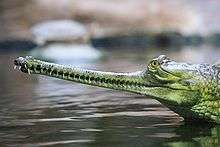Gavialoidea
Gavialoidea is one of three superfamilies of crocodylians, the other two being Alligatoroidea and Crocodyloidea. Although many extinct species are known, only the gharial Gavialis gangeticus and the false gharial Tomistoma schlegelii are alive today.
| Gavialoidea | |
|---|---|
 | |
| Indian gharial, Gavialis gangeticus | |
| Scientific classification | |
| Kingdom: | Animalia |
| Phylum: | Chordata |
| Class: | Reptilia |
| Order: | Crocodilia |
| Superfamily: | Gavialoidea Hay, 1930 |
| Subgroups | |
Extinct South American gavialoids likely dispersed in the mid Tertiary from Africa and Asia.[1] Fossil remains of the Puerto Rican gavialoid Aktiogavialis puertorisensis were discovered in a cave located in San Sebastián, Puerto Rico and dated to the Oligocene. This individual is thought to have crossed the Atlantic coming from Africa, indicating that this species was able to withstand saltwater.[2]
Classification
Gavialoidea contains the family Gavialidae and several more basal extinct forms such as Thoracosaurus and Eosuchus. Within Gavialidae are two subfamilies: Gavialinae, which includes the living gharial, and Gryposuchinae, which includes several extinct forms such as Gryposuchus and Aktiogavialis.[2]
In addition to these groups, recent molecular studies consistently indicate that the false gharial (and by inference other related extinct forms) traditionally viewed as belonging to the crocodylian subfamily Tomistominae actually belong to Gavialoidea.[3] As its name suggests, the false gharial was once thought to be only distantly related to the gharial despite its similar appearance. The false gharial and other tomistomines were traditionally classified within the superfamily Crocodyloidea as close relatives of crocodiles. This classification is based on morphological evidence, which, when incorporated into phylogenetic analyses, often place the group within Crocodyloidea.[4]
Below is a cladogram from Vélez-Juarbe et al. (2007) showing the phylogenetic relationships of members of Gavialoidea, excluding tomistomines.[5]
| Gavialoidea |
| ||||||||||||||||||||||||||||||||||||||||||||||||
References
- Brochu, C. A. (2003). "Phylogenetic approaches toward crocodylian history". Annual Review of Earth and Planetary Sciences. 31 (31): 357–397. Bibcode:2003AREPS..31..357B. doi:10.1146/annurev.earth.31.100901.141308.
- Vélez-Juarbe, J.; Brochu, C. A. & Santos, H. (2007). "A gharial from the Oligocene of Puerto Rico: transoceanic dispersal in the history of a non-marine reptile". Proceedings of the Royal Society. 274 (1615): 1245–1254. doi:10.1098/rspb.2006.0455. PMC 2176176. PMID 17341454.
- Willis, R. E.; McAliley, L. R.; Neeley, E. D.; Densmore Ld, L. D. (June 2007). "Evidence for placing the false gharial (Tomistoma schlegelii) into the family Gavialidae: Inferences from nuclear gene sequences". Molecular Phylogenetics and Evolution. 43 (3): 787–794. doi:10.1016/j.ympev.2007.02.005. PMID 17433721.
- Gatesy, Jorge; Amato, G.; Norell, M.; DeSalle, R.; Hayashi, C. (2003). "Combined support for wholesale taxic atavism in gavialine crocodylians" (PDF). Systematic Biology. 52 (3): 403–422. doi:10.1080/10635150309329.
- Vélez-Juarbe, Jorge; Brochu, C.A.; Santos, H. (2007). "A gharial from the Oligocene of Puerto Rico: transoceanic dispersal in the history of a non-marine reptile". Proceedings of the Royal Society B. 274 (1615): 1245–1254. doi:10.1098/rspb.2006.0455. PMC 2176176. PMID 17341454.